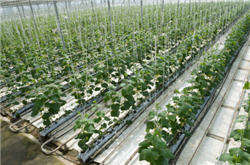Imagine being able to get the equivalent of 70 miles per gallon in your car, keep your home cool and power your computer – all from sewage. Thanks to technology developed by University of California-Irvine’s National Fuel Cell Research Center and partners, that’s now possible.

Gotham Greens, a hydroponics greenhouse facility, sits on a warehouse rooftop and brings new meaning to the phrase "locally grown" – especially atop a 15,000-square-foot manufacturing building in Greenpoint, Brooklyn.
Except for the few temperate regions on the West Coast, air conditioners are now standard equipment in most homes, especially in those newly constructed.
The explosive growth of cities worldwide over the next two decades poses significant risks to people and the global environment, according to a meta-analysis published today in Plos One.
A novel microscopy method at the Department of Energy’s Oak Ridge National Laboratory is helping scientists probe the reactions that limit widespread deployment of fuel cell technologies.
The NASA Ames Sustainability Base in Moffett Field, Calif., has won two awards for sustainability and innovation.
Using government-supplied measurements, the researchers found concentrations of fine particles in Ulaanbaatar’s air were more than seven times the level considered safe by the World Health Organization
A report forecasts that the EV cybersecurity market will increase from just $26 million in 2011 to $144 million by 2015, with a cumulative investment of $432 million during that period.
Researchers at the University of California, Riverside along with their research partners received a $1.2 million grant from the Department of Energy to study and evaluate technologies that provide feedback to drivers so they can cut harmful emissions and reduce fuel use by up to 30 percent.
Undergraduate researcher Safatul Islam is a member of a team in the College of Optical Sciences investigating organic photovoltaics, which can lead to improved electronics.
Improved nutrition for billions of people around the world and the development of clean, green biofuels are two key aims of a major new research center at the University of Adelaide's Waite Campus.
Lake Tahoe clarity dropped in 2010, but the rate of decline in clarity over the past decade remains slower compared with previous decades, according to UC Davis scientists who have monitored the lake for more than 40 years.
As consumers stay focused on keeping cool during the hottest months of the year, they may fall victim to some of the myths that may be giving electricity customers the wrong idea about how to curb their electricity consumption and save money on their monthly bills.
Recent data from NSF-funded research in both Greenland and Antarctica demonstrate that fossil-fuel related emissions of both methane and ethane, two of the most abundant hydrocarbons in the atmosphere, declined at the end of the twentieth century, according to a paper published Thursday in the journal Nature.
Consider the apple core. From an environmental perspective, what’s the most responsible way to dispose of it, or a banana peel, or any food waste?
the Smithsonian’s National Museum of the American Indian launches a new educational website, “American Indian Responses to Environmental Challenges,” that will target middle and high school teachers, students and the general public.
The playground at Bristol Park in Turlock, Calif., is roughly 20 years old, in major need of a facelift and some TLC.
Farmers in the Everglades Agricultural Area (EAA), south of Lake Okeechobee, achieved a record-setting 79 percent phosphorus reduction in the water leaving the farming region -- more than three times less phosphorus than the state requirement.
There are many different types of plants in grasslands around the world. According to a new analysis of plants in grassland ecosystems around the world, it turns out that most of those plant species are important.
Algae-based fuel is one of many options among the array of possible future energy sources. New University of Virginia research shows that while algae-based transportation fuels produce high energy output with minimal land use, their production could come with significant environmental burdens.